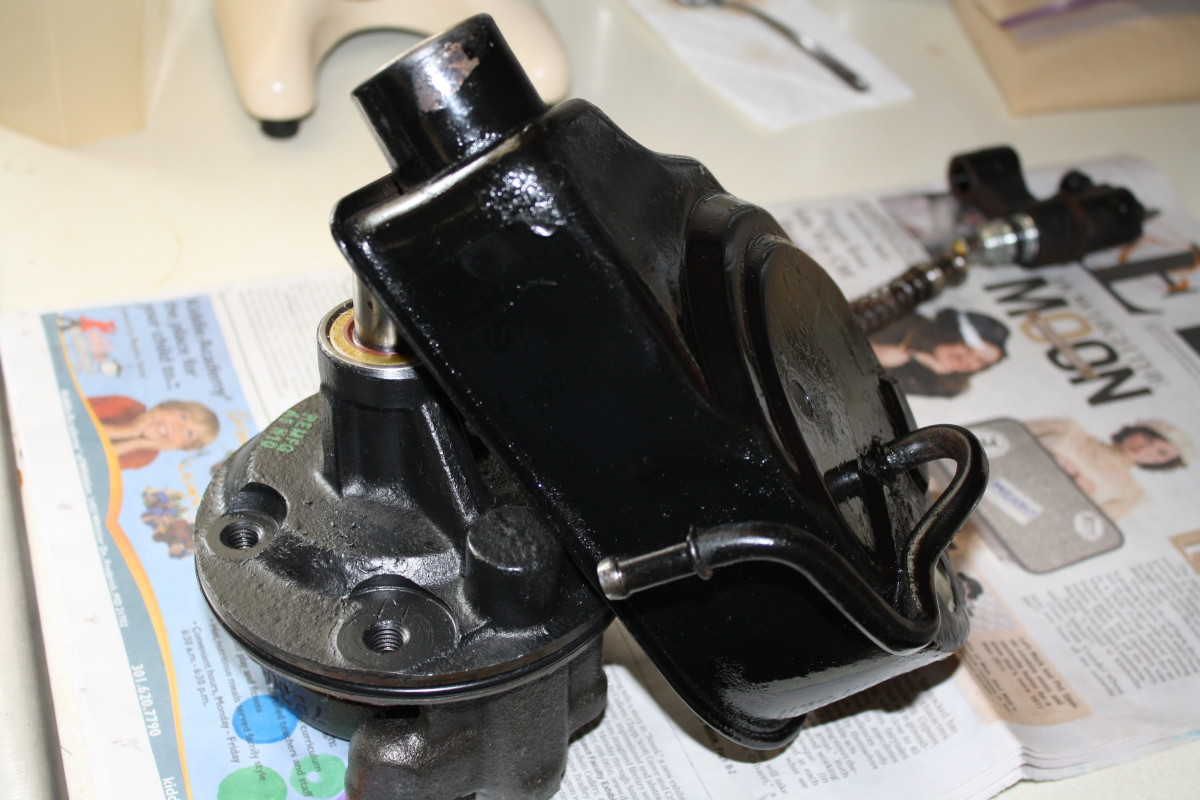Repair power steering systems

Understanding Steering Systems
The most common causes of power steering failure are low fluid or a broken belt, but sometimes there are other reasons. A basic steering system includes the driver's wheel, column, gearbox, pitman arm, relay rod, tie rod, idler arm, steering knuckles, and ball joints or kingpins. Years ago, that was all there was, and with a wrench or two, a pickle fork, and hammer you could fix anything that might go wrong.
Early power steering systems included the standard mechanical parts plus a belt driven pump, hoses, and a hydraulic/mechanical gearbox. Today's steering systems take advantage of more precisely machined parts and additional technology. We now have electro/hydraulic pumps, metering valves, sensors, computers, variable valves, electric motors, filters, and other paraphernalia supposedly designed to improve our driving experience.
When today's modern technological power steering fails, you can't just check the fluid, belt, and hoses anymore! When the sophisticated parts of the system fail, the result is anywhere from sudden unexpected power assist to sudden complete failure or even intermittent failures. In any case, your driving experience gains the benefit of a sudden adrenaline rush, followed by a rush to your local repair shop!
Why No Fluid Flow
If fluid is not flowing, the likely causes are:
- Broken Drive Belt
- No Fluid, caused by a) Split Hose, b) Leaking Seals, c) Leaking Fitting, d) Rusted Reservoir, e) Missing Fill Cap
- Broken pump shaft
- Clogged Filter
- Plugged Pressure Valve
- Plugged EVO Valve
- Clogged Hose.
Diagnosing the power steering system
If you have experienced complete failure of your system, the likely cause is a broken drive belt, torn hose, plugged filter, or a broken pump shaft. A common cause of too much boost or assist is failure of one or more of the sensors in modern vehicles equipped with VES (Variable Effort Steering), sometimes called variable speed assist, and other names.
A VES system detects vehicle speed through wheel or transmission sensors, engine speed through the camshaft or crankshaft sensor, and steering wheel rotation through a column mounted sensor. These inputs are fed to one or more computers that modulate a signal that opens or closes a valve, usually mounted on the pump or gearbox, to provide more or less pressurized fluid to the gearbox. The change in fluid volume makes it easier or more difficult to turn the steering wheel.
If the speed input signal comes from the wheel sensors, the computer regulating the steering effort may be the same computer that regulates the ABS or Anti-lock Braking System, or from the body control module computer. If you are having intermittent steering problems on such a system, you need to have the ABS or BCM computer checked with an ABS or Tech scan tool. Common OBD II (On-Board Diagnostic system II) scan tools available in auto parts stores typically do not scan beyond the PCM (Power Control Module) or ECM (Engine Control Module) computers. The engine computer which is scanned by these inexpensive tools usually will not set a code for brake or steering system problems.
The valve that is modulated by the computer signal is called an EVO (Electrically Variable Orifice) valve. It can go bad, as can any other component in the system, but it is rare for an EVO to fail. It’s fairly easy to replace, however. That’s probably why it doesn’t often fail. When it does, you have full assist at all speeds on most cars. That makes the steering very light at highway speeds. But computer or sensor problems can produce the same symptoms. You can check for voltage at the EVO wire harness to rule out computer/sensor problems.
Checking the pump
To diagnose pump failure, first determine if the pump is actually moving fluid through the steering box. You can check this by first disabling the vehicle’s ignition system. Pull the coil wire (old cars) or the ECM/PCM fuse. Attempt to start the engine to be sure you have disabled the ignition. Then disconnect the RETURN line from the power steering reservoir. The pressure line will run from the pump body or EVO valve and go to the steering box, or if you have hydro boost brakes, it will run from the pump to the hydro boost unit attached to the brake fluid reservoir, then continue to the steering gearbox. With hydro boost brakes, you will have two return lines, one running from the brake boost unit to the power steering fluid reservoir. The steering return line will come from the steering box, maybe go to a fluid cooler (a small radiator) and return to the pump reservoir. Pressure lines are fastened by crimped pressure fittings at both ends. Return lines typically use hose clamps since they don't carry enough pressure to blow off their fittings.
Disconnect the return line after the filter (if any) where it connects to the pump reservoir, and run it to a container. Keep the hose clear of moving parts and crank the engine for a couple of seconds. Check the container for fluid and add new fluid to the reservoir if needed. Don't let the pump run dry. Do this a couple of times to determine if the pump is moving fluid. If it is not, the pump is dead or the flow path is clogged - see the box above. To see if the filter is clogged, disconnect it from the return line and check for pump flow as you did above. If you now have flow, the filter is the problem. If the regulating valve was stuck, the high pressures will have cooked the fluid, turning it dark brown or black. That's a good indication you will need to replace the pump, hoses, and filter.
Any of these conditions mean the pump is probably damaged. Either the pump outright failed or it ran hot, cooking the fluid, because of blockage in the system. If your fluid is pink, it's a good indication your hoses and filter are in good shape, and the pump shaft failed.
If fluid is flowing out the return line, you have eliminated the pump, EVO valve, pressure regulating valve, hoses, filter, and fluid cooling unit. If you still don’t have power steering assist, you have a bad gearbox or a problem with the mechanical linkage from the gearbox to the steering knuckle. These problems are beyond the scope of this article. By the way, this is a diagnosis for steering failure. If your steering is working too good, that is having a very light touch at highway speeds, the EVO valve or column sensor may be bad. They don't always show up on a computer scan.
Assuming you didn't have fluid flow, examine the parts you will need to replace. This includes the pump, hoses, and filter. You can’t thoroughly check the hoses by sight. They rot from the inside out. But replace them if they are over 2 years old, swelled, or cracked. If you have a removable filter screen in the return line, check it for debris. If you see non-metallic gunk stopping the filter, you probably have hoses ready to fail. If you see metallic particles in the screen, you have a serious pump or gearbox problem.
If you don’t have a filter in the system, consider installing one. If you are going to replace the pump, you should know most pump manufacturers will void the warranty if you don’t replace old hoses and install a new filter when you install the new/reman pump.
If you were low on fluid, you need to find out why. Low fluid is caused by leaking hoses or fittings, or bad seals in the pump, reservoir, or steering box. There are some other extreme causes, such as a cracked steering box, or a rusted-through reservoir. Check for fluid stains or wet fluid throughout the system.
If you're sure you need to replace the pump, visit my page "Replacing Your Power Steering Pump" for step-by-step instructions and pictures.



